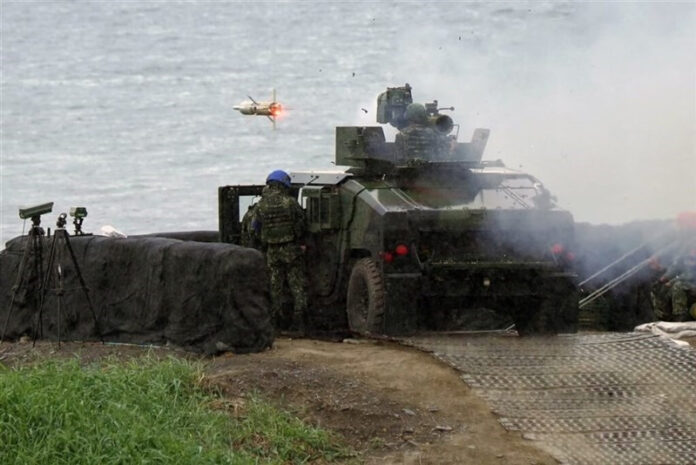Taiwan Initiates War-Readiness Drills Following Chinese Naval Movements in the Taiwan Strait
Overview
In response to increased military activity by China, Taiwan’s Ministry of National Defense (MND) has initiated war-readiness drills across the island. This follows the recent movements of Chinese warships and coast guard vessels entering the Taiwan Strait and the Western Pacific, signaling potential military preparations by Beijing. The Chinese People’s Liberation Army (PLA) has also reserved significant airspace in the region, raising tensions and prompting immediate countermeasures from Taiwan.
Details of the Chinese Naval Activity
On Monday, Taiwan’s military announced that it had detected Chinese warships and coast guard vessels in the Taiwan Strait, a crucial waterway that separates Taiwan from mainland China. These ships are reportedly engaged in long-distance missions in the West Pacific, a strategic region of interest for Beijing.
The PLA has also taken steps to limit airspace access, designating seven temporary reserved airspace zones east of China’s Zhejiang and Fujian provinces. These airspace zones are allocated for exclusive military use for a specific time period, from Monday until Wednesday.
In its statement, the Ministry of National Defense highlighted that PLA Eastern, Northern, and Southern Theater Command naval formations were operating in the waters surrounding Taiwan. The MND also mentioned the presence of Chinese Coast Guard vessels conducting operations near the Taiwan Strait.
Taiwan’s Military Response and War-Readiness Drills
In light of these developments, Taiwan’s military has responded by initiating war-preparedness drills at several key locations across the island. These drills are designed to assess the combat readiness of Taiwan’s armed forces, ensuring that personnel are well-prepared in the event of escalated tensions or conflict.
Additionally, the Taiwan Coast Guard Administration has been actively collaborating with the Ministry of National Defense to formulate countermeasures. This includes monitoring maritime and aerial activity around Taiwan’s territorial waters and airspace.
Diplomatic Context: U.S. Stopovers and Regional Tensions
Local and international sources have speculated that China’s military movements may be a direct response to the recent U.S. stopovers made by President Lai Ching-te during his South Pacific tour. These stops, part of Taiwan’s ongoing diplomatic efforts with its South Pacific allies, have provoked China, which views U.S. involvement in the region as a challenge to its influence.
China’s actions, including the increased naval presence and airspace reservations, suggest that Beijing may be preparing to carry out large-scale military exercises to assert its dominance in the region.
Key Information on the Current Situation
| Activity | Details |
|---|---|
| Chinese Naval Movement | PLA warships and coast guard vessels have entered Taiwan Strait and West Pacific for long-distance missions. |
| Airspace Reservations | Seven temporary airspace zones east of Zhejiang and Fujian have been designated for exclusive military use. |
| Taiwan’s Response | Taiwan has initiated war-preparedness drills and is coordinating with the Taiwan Coast Guard for countermeasures. |
| Diplomatic Context | U.S. President Lai Ching-te’s stopovers in the South Pacific have likely provoked Chinese military activity. |
Frequently Asked Questions (FAQs)
Q: Why is Taiwan conducting war-readiness drills?
A: Taiwan’s Ministry of National Defense initiated the drills in response to increased Chinese naval activity and the designation of reserved airspace zones by China in the Taiwan Strait and surrounding waters. These measures are part of Taiwan’s strategy to maintain national security in the face of rising tensions.
Q: What is the significance of the Chinese warships entering the Taiwan Strait?
A: The presence of Chinese warships in the Taiwan Strait and Western Pacific is a show of force and a signal of China’s growing military presence in the region. It is seen as a response to both Taiwan’s military activities and recent diplomatic interactions between Taiwan and the United States.
Q: What are the temporary reserved airspace zones?
A: The Chinese government has designated seven areas east of its Zhejiang and Fujian provinces as reserved airspace zones, limiting access to military and civilian flights. These zones are allocated for exclusive military use, typically to conduct training or exercises.
Q: How is Taiwan responding to these developments?
A: Taiwan’s military drills aim to test the island’s readiness in the face of potential Chinese aggression. Taiwan has also worked closely with the Coast Guard Administration to enhance maritime security and counter Chinese activities in its territorial waters.
Q: Does the U.S. have a role in escalating tensions?
A: Many analysts believe that China’s recent military actions may be linked to the diplomatic stops made by Taiwanese President Lai Ching-te in the South Pacific. China views these diplomatic engagements with Taiwan’s allies, as well as U.S. involvement, as a challenge to its regional influence.
Conclusion
Taiwan’s decision to initiate war-readiness drills reflects the island’s commitment to safeguarding its sovereignty in the face of increasing military pressure from China. As Chinese naval and coast guard vessels operate in sensitive waters, Taiwan remains on alert, ensuring its forces are prepared for any escalation. The continued geopolitical rivalry between the U.S., Taiwan, and China will likely drive further military and diplomatic developments in the region.
For more updates on this story, please visit https://cialisweb.tw/.
